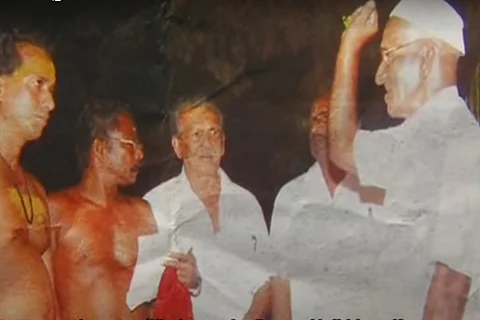

Ever since the release of the film 'The Kerala Story', social media has been abuzz with stories of communal harmony and unity from the state of Kerala. This is our initiative to highlight some of these stories.
Kerala’s Malappuram district, with the highest number of Muslim population in the state, had always been stigmatised for the same reason. But it has always stood as a perfect example of Kerala’s communal harmony. A documentary titled Malappuram Beyond Tales by Thoppil Shahjahan, a journalist from the district, narrates nine heartwarming stories of communal harmony. The PJ Antony Memorial Award winning documentary was released in 2018.
The 23-minute documentary begins at Thunchan Parambu in Tirur, where the memorial of Thunchaththu Ezhuthachan, considered to be the father of modern Malayalam, is located. During the festival of Vijayadashami, thousands of children are brought here, when eminent writers and other personalities help them write their first letter. The whole village is caught up in a festive mood. The documentary shows how a group of Muslim men get together and provide free drinks and milk to children who come for the ceremony. They also act as volunteers to ensure the event runs smoothly.
Kanesh Ponoor, a poet, says, “I am a practising Muslim. This is a Hindu custom, but we think it is wonderful to be part of a tradition that teaches writing.”
In the Sree Kurumba Bhagavathy temple in Shobha Parambu, located 9 km from Thunchan Parambu, the head priest is traditionally appointed by the head of a Muslim family. Bappu Haji, the title given to the eldest member of a Muslim family, also leads the ceremony in which the priest is appointed. This practice still continues. In the documentary, the temple’s priest Rajeev explains happily how his father was appointed to the position by the then Bappu Haji, and after his father’s term he was called to that post by Muhammed Kutty Haji, the current Bappu Haji.
The next story on Malappuram takes to Thirunavaya’s lotus fields. Here the lotuses – cultivated by Muslim farmers – are sold to temples, including the famous Guruvayur Sree Krishna Swamy temple. Some of the temple priests have pointed out how the farmers sell the flowers at subsidised rates to them when the market price is higher.
Another perfect example of communal harmony is Valancherry Moonnakkal Juma Masjid. Hundreds of people – Hindus and Muslims equally – line up at this mosque to get the free ration provided here. Every week, the mosque gives free rice to people living in the limits of the masjid, irrespective of their religion, a practice that the mosque has continued for the last 20 years.
The next place the documentary describes is Kottakkal’s Palappura Juma Masjid. The minbar (pulpit) at this mosque was sponsored by BS Warrier, the founder of Kottakkal Arya Vaidya Sala. He went to Ponnani, a famed Muslim pilgrimage centre, to specifically learn about the minbar there and constructed a similar one in Kottakkal.
In Tirur, the shrine built around the grave of Yakub Thangal, a renowned Sufi spiritual leader, attracts hundreds of devotees, including Hindus. People pray at the shrine and even light the nilavilakku (a Hindu traditional lamp). A festival is also conducted by a Hindu temple nearby to which people throng to.
The story then moves to Kattilangadi Balagokulam, where the floats for the Shobha Yatra (procession) that happens during the Krishna Jayanthi festival are prepared by Iqbal, a Muslim.
Similarly, during a festival at the Mooniyoor Bhagavathy temple, which is called Kaliyattakavu, the devotees first go to the shrine of Muslim preacher Mamburam Thangal, sing songs, and only then visit the temple.
The final story is about the Perinthalmanna Town Juma Masjid. During the holy month of Ramadan, a Hindu man named Piriyani used to burst kadina vedi (a type of firecracker) every day at the time when Muslims break their fast. The crackers, burst traditionally at Hindu shrines, were brought from the Angadipuram temple. But the practice stopped after Piriyani’s death.
“Except for the final practice, everything else still continues in the district with pride. This is just a few of the traditions based on harmony, among hundreds such being practised here,” Shahjahan told TNM.